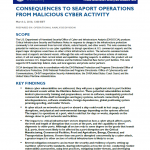Insiders often possess detailed operational and system-security knowledge, as well as authorized physical and systems access to utilities. Insiders can be employees, contractors, service providers, or anyone with legitimate access to utility systems. They often are self-motivated, know system security measures, and raise no alarms due to their authorized systems access. With knowledge of and access to a utility’s network, malicious actors could seize control of utility systems or corrupt information sent to plant operators, causing damage to plant systems and equipment. Systems and networks used by utilities are potential targets for a variety of malicious cyber actors. Threat actors who target these systems may be intent on damaging equipment and facilities, disrupting services, stealing proprietary information, or other malicious activities. The greater the individual’s knowledge and authorized systems access, the greater risk the individual poses. Furthermore, any individual with access to a plant’s systems could unwittingly or inadvertently introduce malware into a system through portable media or by falling victim to socially engineered e-mails.
Read more →

